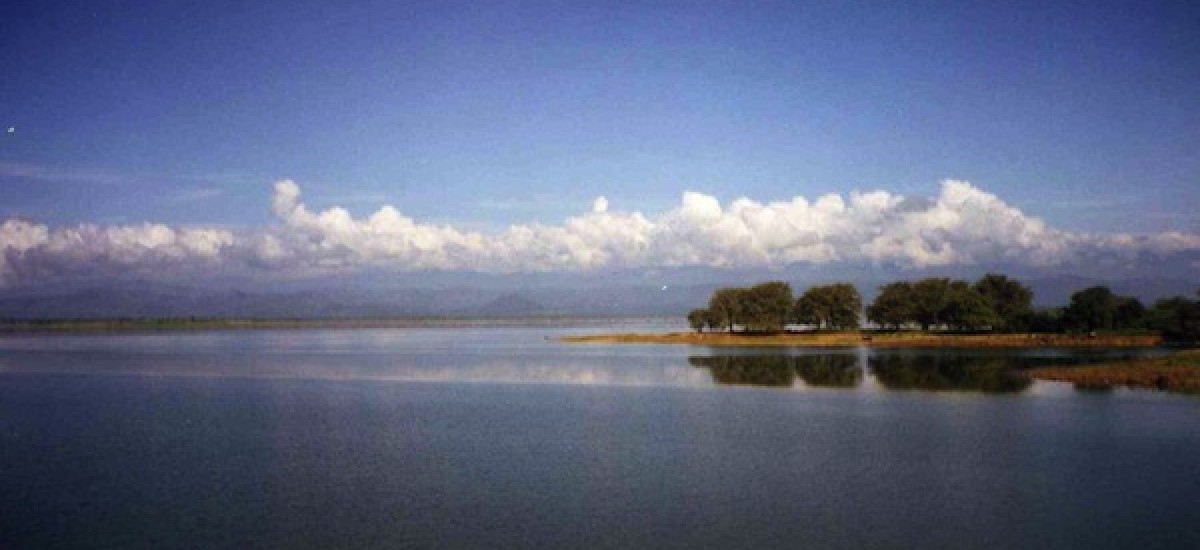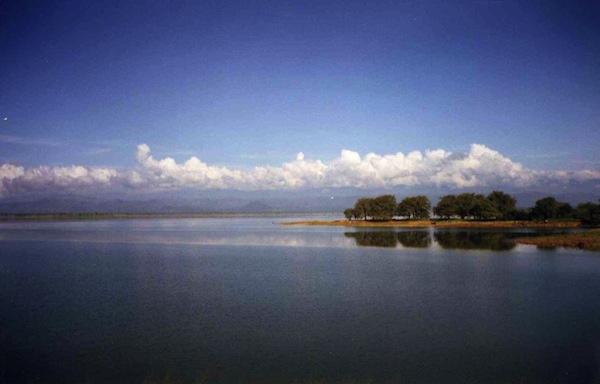Uda Walawe Tank, photo submitted by author
Through the nation water quality has become a serious problem. The Nitrate and Nitrite pollution of the groundwater on the Kalpitiya peninsula, the eutrophication of the hydroelectric reservoirs during low flow, the renal failure syndrome of the North Central province, the rise in neuromuscular diseases among vegetable farmers, are but early symptoms of the malaise that suggests the water quality of the nation being compromised. The load of organic pollutants entering surface waters has affected over 90 percent of the watersheds of the rivers of this country. Further, the decline in water quality is related to a decline in populations aquatic predators of disease bearing mosquitoes, increasing the incidence of vector borne diseases throughout the country.
Though the loss of water quality in Sri Lanka has been dramatic, it is a problem that can be solved. It is still not too late, Nitrates and Nitrites can be removed using deep rooted trees; Organic pollutants are removed through bioremediation; Anthropogenic Forests Analogous to the natural forests that filter polluting chemicals are being established in Sri Lanka and eleven other more countries. The phenomenon of bioconcentration can be used to address the massive emerging problem of renal failures caused by heavy metals in the Anuradhapura area, Forest Garden Tea Estates that clean the water flowing through them are being designed, but no national solution can emerge unless all the competing interests and management agencies are obliged to operate under a National Water Resource Policy and its robust implementation.
The quality and quantity of water also has a significant impact on agricultural productivity and food security, Here the status of both surface and subterranean water are significant in determining the degree of sustainability that a production system possesses. Thus the availability and quality of water becomes a central plank on which the whole question of sustainable development rests. Further, any fossil fuel subsidy to obtain or clean water for use in agriculture needs to be computed into product cost. Otherwise food production in remote places for export creates a greenhouse gas burden that is currently hidden and contributes to production subsidies. Thus the question of the quality, quantity and carbon cost of water in agriculture becomes a subject for consideration by the commission on Sustainable Development.(CSD) and by the IPCC.
For us in Sri Lanka, Where 90 % of household water came from wells or springs, the condition of the surface and shallow aquifer is of critical importance. The internal renewable groundwater resources are estimated at 7.8 km3, most (estimated at 7 km3/year) returning to the river systems and being included in the surface water resources estimate. The current trend of polluting the surface water, if not checked would place us in a situation similar to Honduras where almost all surface and shallow aquifer water is polluted and people have to depend on bottled water for drinking. Today two companies Coca Cola and Pepsi Cola control the drinking water supply and distribution through most of that country.
The value of clean surface water becomes even more urgent when the following water statistics are considered:
97.5% of all water on Earth is salt water, leaving only 2.5% as fresh water
Nearly 70% of that fresh water is frozen in the icecaps of Antarctica and Greenland; most of the remainder is present as soil moisture, or lies in deep underground aquifers as groundwater not accessible to human use.
Less than 1% of the world’s fresh water (~0.007% of all water on earth) is accessible for direct human uses. This is the water found in lakes, rivers, reservoirs and those underground sources that are shallow enough to be tapped at an affordable cost. Only this amount is regularly renewed by rain and snowfall, and is therefore available on a sustainable basis.
Thus the internal, renewable groundwater resources of the country, should be monitored and developed such that the condition of its surface waters be a primary responsibility of the state, expressed at the local government level.
The condition of surface water is easily evaluated using a suite of indicator species in addition to the physical/chemical variables. These can range from macroorganisms such as fishes or insects to microorganisms such as diatoms or plankton. Voluminous studies demonstrate the correlation between water quality and aquatic organisms. However, at a local level there does not exist the capacity to use or appreciate such knowledge. Thus programs to help communities asses the quality of their surface waters using indicator species can prove especially useful. Such programs can even be tied to school education curricula and ‘Stream or Lake Watch’ can be constructed on the successful models of ‘salt watch’ or ‘frog watch’ in Australia or ‘Adopt a Watershed’ in the USA. Indicator species of water quality can be effectively addressed if they form the basis of monitoring and evaluation of development processes as applied to surface water systems.
Agriculture has been demonstrated to have either a positive or negative effect on water quality depending on the agricultural technology used. Thus, if we promote incentive schemes for the improvement of water quality and quantity increase and disincentive schemes for the reduction of water quality and quantity, better control on the nations water quality could be gained. Adopting the user pays principle; those who pollute water must be taxed while those who improve water must be rewarded. This will enable many farmers to use and husband their lands effectively.‘
Deep well groundwater extraction is a non-sustainable activity, Although the deep aquifers are slowly charged with deep infiltration of rainwater, it can never be replaced at the rates that deep well extraction demands. This has led to land collapse over certain wells and intrusion of salt into others. Research conducted by University of Tokyo suggest that it has also contributed to the rising of sea levels.
“Together, unsustainable groundwater use, artificial reservoir water impoundment, climate-driven change in terrestrial water storage and the loss of water from closed basins have contributed a sea-level rise of 0.77mm (0.031 inches) per year between 1961 and 2003, about 42 percent of the observed sea-level rise”
Just a tiny rise, if repeated year on year, will eventually have a dramatic impact in locations that are vulnerable to storm surges or the influx of saltwater into aquifers or coastal fields. Thus deep aquifer water extraction should be re-examined in the light of today’s knowledge.
Living on a densely populated island, requires us to be extremely vigilant about our water, its quality, quantity and ownership. The way in which we use and manage our water resources today will determine the degree of comfort or hardship that the population of tomorrow will inherit. This is too important a topic to be distanced in public discussions or political platforms.
Read Part 1 of this article here.


